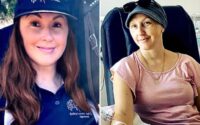Mystery of why babies kick in the womb solved after centuries: scientists
The centuries-old mystery of why babies kick their mamas in the gut has finally been solved, according to a new peer-reviewed study published in the journal Proceedings of the National Academy of Sciences.
Unborn babes begin to flutter, wiggle, roll around and, yes, kick inside the womb as early as 16 weeks into the average pregnancy. The “spontaneous movements” were long believed to happen at random — until new research revealed that these exercises help them train their little bodies.
Scientists from the University of Tokyo have discovered that working out in utero actually plays a crucial role in early child development, including hand-eye coordination.
“We were surprised that during spontaneous movement, infants’ movements ‘wandered’ and they pursued various sensorimotor interactions,” said lead study author Hoshinori Kanazawa, a professor at the University of Tokyo. “We named this phenomenon ‘sensorimotor wandering.’ ”

The average in utero kick can carry a force of more than 10 pounds — and has mystified scientists for centuries, according to prior research published in the Journal of the Royal Society Interface. However, the new case study model has revealed just how this physical activity actually helps the infant learn to control its body.


The research team used motion capture technology to record the joint movements of 12 healthy newborns — all less than 10 days old— as well as 10 young infants all about 3 months old.
A musculoskeletal computer model tracked muscle activity and sensory input throughout the whole body. Researchers found that patterns of muscle interaction developed based on the babies’ random exploratory behavior and later helped them to perform sequential movements.
Previous research had focused on movements in the joints or a part of the body versus this new work which studied muscle activity and sensory input signals for the whole body.

“It has been commonly assumed that sensorimotor system development generally depends on the occurrence of repeated sensorimotor interactions, meaning the more you do the same action the more likely you are to learn and remember it,” Kanazawa explained.
“However, our results implied that infants develop their own sensorimotor system based on explorational behavior or curiosity, so they are not just repeating the same action but a variety of actions. In addition to this, our findings provide a conceptual linkage between early spontaneous movements and spontaneous neuronal activity.”
A better understanding of how our sensorimotor system develops could help us gain insight into the origin of human movement — as well as achieve earlier diagnosis of developmental disorders, researchers reported.
Meanwhile, this is just the latest discovery of how a baby’s body — and brain — develop in the womb.
Another recent study found that just one alcoholic beverage a week during pregnancy can impact a baby’s brain. Babies exposed to even low to moderate amounts of alcohol had the shape of their brains physically altered and delayed brain development.
Next up, Kanazawa wants to look at how sensorimotor wandering affects later development, such as walking and reaching, along with more complex behaviors and higher cognitive functions.
“My original background is in infant rehabilitation,” he said. “My big goal through my research is to understand the underlying mechanisms of early motor development and to find knowledge that will help to promote baby development.”


